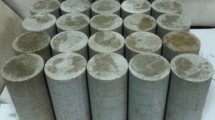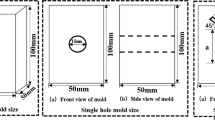Abstract
To explore the mechanical behaviors and energy evolution characteristics of rock materials with hole defects, eight types of red sandstone specimens with different hole numbers and arrangements were subjected to a series of single-cycle loading-unloading uniaxial compression tests. The experimental result revealed that the mechanical behaviors and energy evolution characteristics of the red sandstone specimens are significantly influenced by hole defects. As the number of boreholes increases, the compressive strength of rock specimens decreases. When the angle between drilling hole arrangement and loading direction changes from 0° to 27° and then to 90°, the compressive strength first decreases and then increases, and shear-splitting, splitting, and shear failure modes appear respectively. The experimental results also show that the energy evolution characteristics (linear energy storage and dissipation laws) of the rock specimens with hole defects were basically consistent with that of intact rock specimens, while the energy storage coefficient is different in various cases. There was a good correspondence between the compressive strength and energy storage coefficient. The larger the energy storage coefficient is, the greater the compressive strength. The hole arrangement angle shows a stronger effect on energy storage coefficient and compressive strength than the number of holes. Among all the arrangements, the rock specimens containing three holes with an angle of 27° between borehole arrangement and loading direction have the lowest energy storage coefficient and compression strength. The above research results provide a scientific basis for rock fracturing induced by drilling.
















Similar content being viewed by others
References
Ai C, Zhang J, Li YW, Zeng J, Yang XL, Wang JG (2016) Estimation criteria for rock brittleness based on energy analysis during the rupturing process. Rock Mech Rock Eng 49(12):4681–4698
Bahaaddini M, Hosseinpour ME (2019) Evaluation of empirical approaches in estimating the deformation modulus of rock masses. Bull Eng Geol Environ 78(5):3493–3507
Bernabé Y, Revil A (1995) Pore-scale heterogeneity, energy dissipation and the transport properties of rocks. Geophys Res Lett 22(12):1529–1532
Cai MF (2016) Prediction and prevention of rockburst in metal mines: a case study of Sanshandao gold mine. J Rock Mech Geotech Eng 8(2):204–211
Chang LF, Konietzky H (2018) Application of the mohr-coulomb yield criterion for rocks with multiple joint sets using fast lagrangian analysis of continua 2D (FLAC2D) software. Energies 11(3):614
Chen GQ, Jiang WZ, Sun X, Zhao C, Qin CA (2019) Quantitative evaluation of rock brittleness based on crack initiation stress and complete stress–strain curves. Bull Eng Geol Environ 78(8):5919–5936
Deng Y, Chen M, Jin Y, Zou DW (2016) Theoretical analysis and experimental research on the energy dissipation of rock crushing based on fractal theory. J Nat Gas Sci Eng 33:231–239
Ewy RT, Cook NGW (1990) Deformation and fracture around cylindrical openings in rock I. Observations and analysis of deformations. Int J Rock Mech Min Sci 27(5):387–407
Gao L, Gao F, Zhang ZZ, Xing Y (2020) Research on the energy evolution characteristics and the failure intensity of rocks. Int J Min Sci Technol 30(5):705–713
Gong FQ, Luo S, Yan JY (2018a) Energy storage and dissipation evolution process and characteristics of marble in three tension-type failure tests. Rock Mech Rock Eng 51(11):3613–3624
Gong FQ, Yan JY, Li XB (2018b) A new criterion of rock burst proneness based on the linear energy storage law and the residual elastic energy index. Chin J Rock Mech Eng 37(9):1993–2014
Gong FQ, Yan JY, Luo S (2019) Investigation on the linear energy storage and dissipation laws of rock materials under uniaxial compression. Rock Mech Rock Eng 52(12):4237–4255
Gong FQ, Wang YL, Luo S (2020) Rockburst proneness criteria for rock materials: review and new insights. J Cent South Univ 27(10):2793–2821
Gong FQ, Wang YL, Wang ZG (2021) A new criterion of coal burst proneness based on the residual elastic energy index. Int J Min Sci Technol 2095-2686.(In press)
Han GS, Jing HW, Su HJ (2017) Experimental study on compressive strength and fracture characteristics of sandstone containing double circular cavities. J China Coal Soc 42(4):871–878
Hua AZ, You MQ (2001) Rock failure due to energy release during unloading and application to underground rock burst control. Tunnel Underg Space Technol 16(3):241–246
Jia CJ, Xu WY, Wang SS, Wang RB, Yu J (2019) Experimental analysis and modeling of the mechanical behavior of breccia lava in the dam foundation of the Baihetan Hydropower Project. Bull Eng Geol Environ 78(4):2681–2695
Jiang Q, Feng XT, Xiang TB, Su GS (2010) Rock burst characteristics and numerical simulation based on a new energy index: a case study of a tunnel at 2500 m depth. Bull Eng Geol Environ 69(3):381–388
Ju Y, Wang HJ, Yang YM, Hu QA, Peng RD (2010) Numerical simulation of mechanisms of deformation, failure and energy dissipation in porous rock media subjected to wave stresses. Sci China Technol Sci 53(4):1098–1113
Li SJ, Feng XT, Li ZH, Chen BR, Zhang CQ, Zhou H (2012) In situ monitoring of rockburst nucleation and evolution in the deeply buried tunnels of Jinping II hydropower station. Eng Geol 137–138:85–96
Li YR, Huang D, Li XA (2014) Strain rate dependency of coarse crystal marble under uniaxial compression: strength, deformation and strain energy. Rock Mech Rock Eng 47(4):1153–1164
Lin P (2002) Brittle failure behavior of medium containing flaws and pores. Chin J Rock Mech Eng 21(8):1283–1283
Lin P, Wong RHC, Tang CA (2015) Experimental study of coalescence mechanisms and failure under uniaxial compression of granite containing multiple holes. Int J Rock Mech Min Sci 77:313–327
Luo S, Gong FQ (2020a) Energy storage and dissipation laws of rocks under preset angle shear conditions. Rock Mech Rock Eng 53:3303–3323
Luo S, Gong FQ (2020b) Linear energy storage and dissipation laws during rock fracture under three-point flexural loading. Eng Fract Mech 234:107102
Medina-Retina Z, Arson C (2014) Probabilistic calibration of a damage rock mechanics model. Geotech Lett 4:17–21
Meng QB, Zhang MW, Ha LJ, Pu H, Nie TY (2016) Effects of acoustic emission and energy evolution of rock specimens under the uniaxial cyclic loading and unloading compression. Rock Mech Rock Eng 49(10):1–14
Meng QB, Zhang MW, Han LJ, Pu H, Chen YL (2019) Experimental research on the influence of loading rate on the mechanical properties of limestone in a high-temperature state. Bull Eng Geol Environ 78(5):3479–3492
Miao SJ, Cai MF, Guo QF, Huang ZJ (2016) Rock burst prediction based on in situ stress and energy accumulation theory. Int J Rock Mech Min Sci 83:86–94
Peng RD, Ju Y, Wang JG, Xie HP, Gao F, Mao LT (2015) Energy dissipation and release during coal failure under conventional triaxial compression. Rock Mech Rock Eng 48(2):509–526
Peng J, Wong LNY, Zhang Y (2020) Influence of pore-like flaws on strength and micro-cracking behavior of crystalline rock. Int J Numer Anal Met. https://doi.org/10.1002/nag.3171
Sammis CG, Ashby MF (1986) The failure of brittle porous solids under compressive stress states. Acta Metall 34(3):511–526
Song DZ, Wang EY, Liu J (2012) Relationship between EMR and dissipated energy of coal rock mass during cyclic loading process. Saf Sci 50(4):751–760
Su YQ, Gong FQ, Luo S (2021) Experimental study on the energy storage and dissipation characteristics of granite under two-dimensional compression with constant confining pressure. J Cent South Univ 28(3):848–865
Sujatha V, Kishen JMC (2003) Energy release rate due to friction at bimaterial interface in dams. J Eng Mech 129(7):793–800
Wasantha PL, Ranjith PG, Shao SS (2014) Energy monitoring and analysis during deformation of bedded-sandstone: use of acoustic emission. Ultrasonics 54(1):21
Wong RHC, Chau KT (1998) Crack coalescence in a rock-like material containing two cracks. Int J Rock Mech Min Sci 35:147–164
Wong LNY, Einstein HH (2009) Crack coalescence in molded gypsum and Carrara marble: part 1. Macroscopic observations and interpretation. Rock Mech Rock Eng 42(3):475–511
Wong RHC, Lin P (2015) Numerical study of stress distribution and crack coalescence mechanisms of a solid containing multiple holes. J Rock Mech Geotech Eng 79:41–54
Wong LNY, Peng J (2020) Numerical investigation of micro-cracking behavior of brittle rock containing a pore-like flaw under uniaxial compression. Int J Damage Mech 29(10):1543–1568
Wong RHC, Lin P, Tang CA (2006) Experimental and numerical study on splitting failure of brittle solids containing single pore under uniaxial compression. Mech Mater 38:142–159
Wu H, Zhao GY, Liang WZ (2019a) Investigation of cracking behavior and mechanism of sandstone specimens with a hole under compression. Int J Mech Sci 127:105084
Wu H, Pinnaduwa HSWK, Zhao GY, Liang WZ, Wang EJ (2019b) A comprehensive study of fracture evolution of brittle rock containing an inverted U-shaped cavity under uniaxial compression. Comput Geotech 116:103219–103219
Xie HP, Peng RD, Ju Y (2004) Energy dissipation of rock deformation and fracture. Chin J Rock Mech Eng 23(21):3565–3570
Xie HP, Li LY, Peng RD, Ju Y (2009) Energy analysis and criteria for structural failure of rocks. J Rock Mech Geotech Eng 1(1):11–20
Xie HP, Li LY, Ju Y, Peng RD, Yang YM (2011) Energy analysis for damage and catastrophic failure of rocks. Sci China Technol Sci 54(Suppl 1):199–209
Xu L, Gong FQ, Luo S (2021) Effects of pre-existing single crack angle on mechanical behaviors and energy storage characteristics of red sandstone under uniaxial compression. Theor Appl Fract Mech 113:102933
Zhang ZZ, Gao F (2015) Exerimental investigation on the energy evolution of dry and water-saturated red sandstones. Int J Min Sci Technol 25(3):383–388
Zhang C, Tang JX, Teng JY (2017) Experimental study of influence of pore number and pore size on mechanical properties of marble. Rock Soil Mech S2:41–50
Zhang SC, Li YY, Shen BT, Sun XZ, Gao LQ (2019) Effective evaluation of pressure relief drilling for reducing rock bursts and its application in underground coal mines. Int J Rock Mech Min Sci 114:7–16
Zhu TT, Jing HW, Su HJ (2014) Mechanical behavior of sandstone containing double circular cavities under uniaxial compression. Chin J Geo Eng 37(6):1047–1056
Funding
This work was supported by the National Natural Science Foundation of China (Grant No. 41877272) and the Fundamental Research Funds for the Central Universities of Southeast University (Grant No. 2242021R10080).
Author information
Authors and Affiliations
Corresponding author
Rights and permissions
About this article
Cite this article
He, Z., Gong, F., Wu, W. et al. Experimental investigation of the mechanical behaviors and energy evolution characteristics of red sandstone specimens with holes under uniaxial compression. Bull Eng Geol Environ 80, 5845–5865 (2021). https://doi.org/10.1007/s10064-021-02260-z
Received:
Accepted:
Published:
Issue Date:
DOI: https://doi.org/10.1007/s10064-021-02260-z




